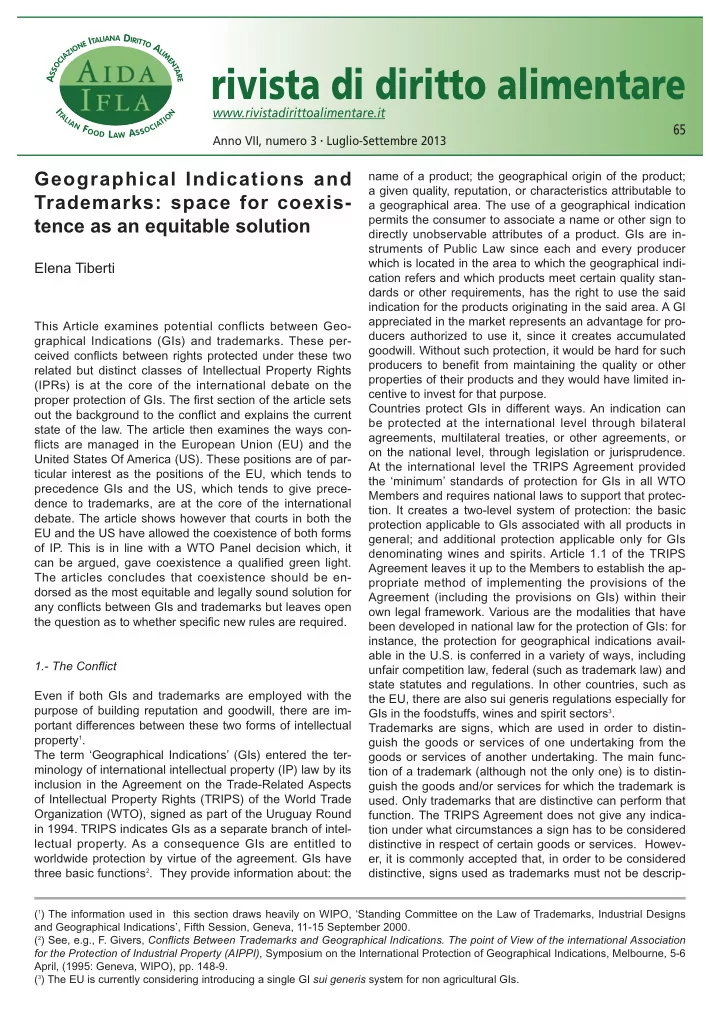

D L I A N A I A I R T I T T E O N A O I Z L I A M I C E N O T S rivista di diritto alimentare A S R A E I www.rivistadirittoalimentare.it N T A O L I T I A A N I C 65 F O O S A S O L D A W Anno VII, numero 3 • Luglio-Settembre 2013 name of a product; the geographical origin of the product; Geographical Indications and a given quality, reputation, or characteristics attributable to Trademarks: space for coexis- a geographical area. The use of a geographical indication permits the consumer to associate a name or other sign to tence as an equitable solution directly unobservable attributes of a product. GIs are in- struments of Public Law since each and every producer which is located in the area to which the geographical indi- Elena Tiberti cation refers and which products meet certain quality stan- dards or other requirements, has the right to use the said indication for the products originating in the said area. A GI appreciated in the market represents an advantage for pro- This Article examines potential conflicts between Geo- ducers authorized to use it, since it creates accumulated graphical Indications (GIs) and trademarks. These per- goodwill. Without such protection, it would be hard for such ceived conflicts between rights protected under these two producers to benefit from maintaining the quality or other related but distinct classes of Intellectual Property Rights properties of their products and they would have limited in- (IPRs) is at the core of the international debate on the centive to invest for that purpose. proper protection of GIs. The first section of the article sets Countries protect GIs in different ways. An indication can out the background to the conflict and explains the current be protected at the international level through bilateral state of the law. The article then examines the ways con- agreements, multilateral treaties, or other agreements, or flicts are managed in the European Union (EU) and the on the national level, through legislation or jurisprudence. United States Of America (US). These positions are of par- At the international level the TRIPS Agreement provided ticular interest as the positions of the EU, which tends to the ‘minimum’ standards of protection for GIs in all WTO precedence GIs and the US, which tends to give prece- Members and requires national laws to support that protec- dence to trademarks, are at the core of the international tion. It creates a two-level system of protection: the basic debate. The article shows however that courts in both the protection applicable to GIs associated with all products in EU and the US have allowed the coexistence of both forms general; and additional protection applicable only for GIs of IP. This is in line with a WTO Panel decision which, it denominating wines and spirits. Article 1.1 of the TRIPS can be argued, gave coexistence a qualified green light. Agreement leaves it up to the Members to establish the ap- The articles concludes that coexistence should be en- propriate method of implementing the provisions of the dorsed as the most equitable and legally sound solution for Agreement (including the provisions on GIs) within their any conflicts between GIs and trademarks but leaves open own legal framework. Various are the modalities that have the question as to whether specific new rules are required. been developed in national law for the protection of GIs: for instance, the protection for geographical indications avail- able in the U.S. is conferred in a variety of ways, including 1.- The Conflict unfair competition law, federal (such as trademark law) and state statutes and regulations. In other countries, such as Even if both GIs and trademarks are employed with the the EU, there are also sui generis regulations especially for purpose of building reputation and goodwill, there are im- GIs in the foodstuffs, wines and spirit sectors 3 . portant differences between these two forms of intellectual Trademarks are signs, which are used in order to distin- property 1 . guish the goods or services of one undertaking from the The term ‘Geographical Indications’ (GIs) entered the ter- goods or services of another undertaking. The main func- minology of international intellectual property (IP) law by its tion of a trademark (although not the only one) is to distin- inclusion in the Agreement on the Trade-Related Aspects guish the goods and/or services for which the trademark is of Intellectual Property Rights (TRIPS) of the World Trade used. Only trademarks that are distinctive can perform that Organization (WTO), signed as part of the Uruguay Round function. The TRIPS Agreement does not give any indica- in 1994. TRIPS indicates GIs as a separate branch of intel- tion under what circumstances a sign has to be considered lectual property. As a consequence GIs are entitled to distinctive in respect of certain goods or services. Howev- worldwide protection by virtue of the agreement. GIs have er, it is commonly accepted that, in order to be considered three basic functions 2 . They provide information about: the distinctive, signs used as trademarks must not be descrip- ( 1 ) The information used in this section draws heavily on WIPO, ‘Standing Committee on the Law of Trademarks, Industrial Designs and Geographical Indications’, Fifth Session, Geneva, 11-15 September 2000. ( 2 ) See, e.g., F. Givers, Conflicts Between Trademarks and Geographical Indications. The point of View of the international Association for the Protection of Industrial Property (AIPPI) , Symposium on the International Protection of Geographical Indications, Melbourne, 5-6 April, (1995: Geneva, WIPO), pp. 148-9. ( 3 ) The EU is currently considering introducing a single GI sui generis system for non agricultural GIs.
Recommend
More recommend